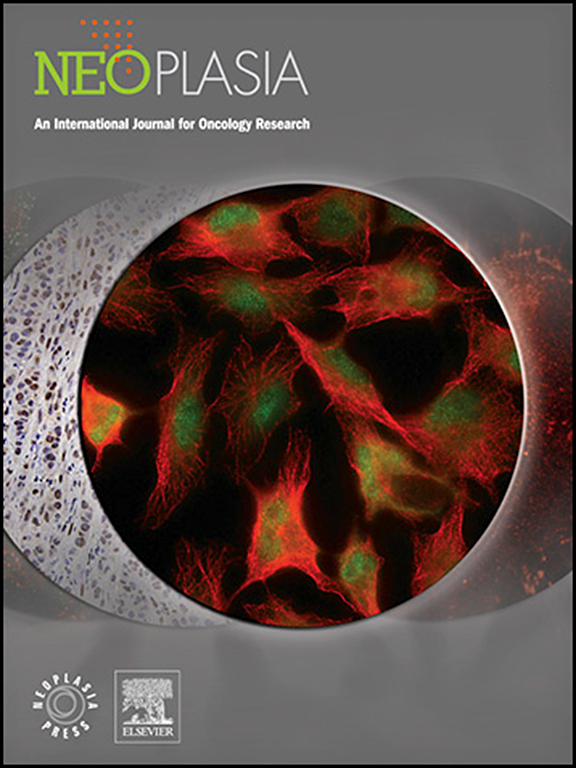通过全基因组活体CRISPR筛选鉴定肺癌免疫治疗靶点TUBB3。
IF 4.8
2区 医学
Q1 Biochemistry, Genetics and Molecular Biology
引用次数: 0
摘要
免疫检查点抑制剂的最新发展彻底改变了癌症免疫疗法。虽然这些药物对一部分癌症患者产生了显著疗效,但还有很多肿瘤患者对这些药物没有反应,而且抗药性的病理机制在很大程度上还不清楚。为了用系统的方法找出抗PD-1免疫疗法耐药的基因,我们在肺癌细胞中进行了体内全基因组CRISPR筛选。我们将结果与多组学临床数据相结合,并进行了体外和体内试验,以评估候选基因在调控细胞毒性 T 细胞杀伤中的作用。我们发现TUBB3是克服抗PD-1免疫疗法耐药性和提高疗效的潜在靶点。TUBB3在肺癌患者中表达上调,其较高的表达与患者较差的生存率相关。我们发现,在接受免疫疗法的患者队列中,与应答者相比,无应答者的 TUBB3 表达明显升高。重要的是,我们的临床前实验结果表明,用小分子抑制剂抑制 TUBB3 可与抗 PD-1 治疗产生协同作用,增强细胞毒性 T 细胞对肿瘤细胞的杀伤力。同样,抗PD-1耐药细胞的TUBB3表达量明显更高;然而,抑制TUBB3可使耐药细胞更易被T细胞杀死。机理研究显示,阻断 TUBB3 可通过 EMT 相关的 SNAI1 基因抑制 PD-L1 的表达。我们的研究结果为由TUBB3抑制和抗PD-1免疫疗法组成的新型肺癌联合疗法提供了理论依据。本文章由计算机程序翻译,如有差异,请以英文原文为准。
Identification of TUBB3 as an immunotherapy target in lung cancer by genome wide in vivo CRISPR screening
Recent development of immune checkpoint inhibitors has revolutionized cancer immunotherapy. Although these drugs show dramatic effects on a subset of cancer patients, many other tumors are non-responsive and the pathological mechanism of the resistance is largely unknown. To identify genes underlying anti-PD-1 immunotherapy resistance using a systematic approach, we performed an in vivo genome wide CRISPR screening in lung cancer cells. We integrated our results with multi-omics clinical data and performed both in vitro and in vivo assays to evaluate the role of the top candidate in regulating cytotoxic T cell killing. We identified TUBB3 as a potential target to overcome the resistance and enhance the efficacy of anti-PD-1 immunotherapy. TUBB3 expression is upregulated in lung cancer patients, and its higher expression correlates with poorer patients’ survival. We found that TUBB3 expression was significantly elevated in the non-responders compared to responders in our patient cohort that received immunotherapies. Importantly, the results of our preclinical experiments showed that inhibition of TUBB3 with a small molecule inhibitor synergized with anti-PD-1 treatment and enhanced tumor cell killing by cytotoxic T cells. Consistently, anti-PD-1 resistant cells showed significantly higher expression of TUBB3; however, TUBB3 inhibition rendered the resistant cells more susceptible to T cell killing. Mechanistic studies revealed that blocking TUBB3 suppressed the expression of PD-L1 through the EMT-related SNAI1 gene. Our results provide a rationale for a novel combination therapy consisting of the TUBB3 inhibition and anti-PD-1 immunotherapy for lung cancer.
求助全文
通过发布文献求助,成功后即可免费获取论文全文。
去求助
来源期刊

Neoplasia
医学-肿瘤学
CiteScore
9.20
自引率
2.10%
发文量
82
审稿时长
26 days
期刊介绍:
Neoplasia publishes the results of novel investigations in all areas of oncology research. The title Neoplasia was chosen to convey the journal’s breadth, which encompasses the traditional disciplines of cancer research as well as emerging fields and interdisciplinary investigations. Neoplasia is interested in studies describing new molecular and genetic findings relating to the neoplastic phenotype and in laboratory and clinical studies demonstrating creative applications of advances in the basic sciences to risk assessment, prognostic indications, detection, diagnosis, and treatment. In addition to regular Research Reports, Neoplasia also publishes Reviews and Meeting Reports. Neoplasia is committed to ensuring a thorough, fair, and rapid review and publication schedule to further its mission of serving both the scientific and clinical communities by disseminating important data and ideas in cancer research.
 求助内容:
求助内容: 应助结果提醒方式:
应助结果提醒方式:


